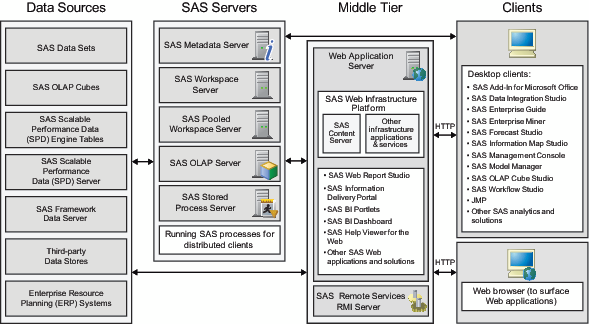Architecture of the SAS Intelligence Platform
Architecture Overview
The SAS Intelligence
Platform architecture is designed to efficiently access large amounts
of data, while simultaneously providing timely intelligence to a large
number of users. The platform uses an n-tier architecture that enables
you to distribute functionality across computer resources, so that
each type of work is performed by the resources that are best suited
to the job.
You can easily scale
the architecture to meet the demands of your workload. For a large
company, the tiers can be installed across a multitude of machines
with different operating systems. For prototyping, demonstrations,
or very small enterprises, all of the tiers can be installed on a
single machine.
Data sources store
your enterprise data. All of your existing data assets can be used,
whether your data is stored in third-party database management systems,
SAS tables, or enterprise resource planning (ERP) system tables.
SAS servers perform
SAS processing on your enterprise data. Several types of SAS servers
are available to handle different workload types and processing intensities.
The software distributes processing loads among server resources so
that multiple client requests for information can be met without delay.
The middle tier enables
users to access intelligence data and functionality via a Web browser.
This tier provides Web-based interfaces for report creation and information
distribution, while passing analysis and processing requests to the
SAS servers.
The client tier provides
users with desktop access to intelligence data and functionality through
easy-to-use interfaces. For most information consumers, reporting
and analysis tasks can be performed with just a Web browser. For more
advanced design and analysis tasks, SAS client software is installed
on users' desktops.
Data Sources
The SAS Intelligence
Platform includes the following options for data storage:
-
The SAS Framework Data Server, which is the default location for middle-tier data such as alerts, comments, and workflows, as well as data for the SAS Content Server and SAS Service Parts Optimization. The server is provided as an alternative to using a third-party DBMS. (The server cannot be used as a general-purpose data store.)
In addition, SAS provides products that enable you to
access data in your existing third-party data stores and ERP systems.
The SAS/ACCESS interfaces provide direct access to data stores such
as the following:
For a complete list of supported data stores, go to http://support.sas.com/software/products/access/.
The following
SAS Data Surveyor products provide direct access to ERP systems:
-
SAS Data Surveyor for Clickstream Data is a plug-in to SAS Data Integration Studio. This plug-in enables you to create jobs that extract and transform clickstream data from Web logs, and then load the resulting data into a SAS table. Other applications, such as SAS Web Analytics, can then take the refined clickstream data and analyze it.
For more information
about data sources, see Data in the SAS Intelligence Platform.
